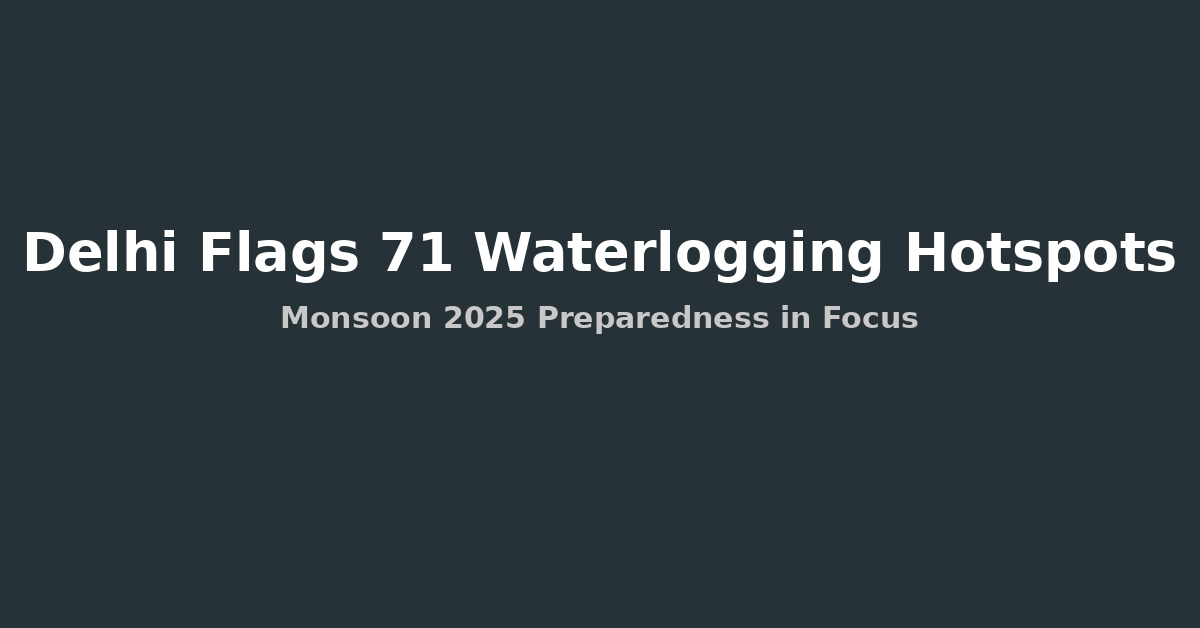As monsoon clouds gather over the capital, Delhi’s civic authorities are racing against time to prevent another season of flooding and disruption. The Delhi government has flagged 71 critical waterlogging hotspots across the city, pushing multiple departments into action to implement structural fixes, streamline desilting efforts, and improve coordination.
This move comes in response to repeated flooding of key intersections, underpasses, and low-lying zones during even mild pre-monsoon showers earlier this June.
A Familiar Crisis with New Accountability
Despite annual monsoon preparations, Delhi continues to struggle with waterlogging year after year. The root causes include:
- Outdated stormwater infrastructure
- Delayed or incomplete desilting
- Encroachments blocking natural drains
- Overloaded drainage networks in rapidly urbanizing pockets
This year, authorities say they’re taking a more structured and accountable approach.
According to officials, each of the 71 critical sites now has a designated engineer or nodal officer responsible for ensuring timely action. These sites include vulnerable points like Minto Bridge, Pul Prahladpur, Zakhira flyover, and areas in north and west Delhi that faced early flooding even before the full onset of the rains.
What Each Department Is Doing
Public Works Department (PWD)
The PWD is leading efforts at major underpasses and arterial roads. It aims to:
- Complete all desilting work by June 15
- Ensure sump pumps are operational and connected to power backups
- Monitor cleaning and pumping via GPS-enabled machines
In the past, PWD had been blamed for lapses—especially at Minto Bridge, where vehicles routinely get submerged. This year, the department claims to have created a 24×7 control room and is conducting spot inspections under ministerial oversight.
Delhi Jal Board (DJB) and Irrigation & Flood Control
The DJB is clearing larger trunk drains and tackling natural water channels often choked with construction waste and encroachments. The irrigation department is working to revitalize stormwater drains and natural outflows leading to the Yamuna.
Municipal Bodies: MCD and NDMC
The MCD has flagged over 335 of the 445 total waterlogging sites under its jurisdiction. Their action plan includes:
- Deployment of mobile water pumps
- Emergency flood teams in each ward
- Zone-wise monitoring dashboards for local engineers
NDMC, which oversees Lutyens’ Delhi and nearby zones, claims to have cleaned 90% of its drains. It is also installing automated sensors at sump wells and underpasses to trigger instant pumping when water reaches danger levels.
Delhi’s Drainage System: Still a Structural Weakness
Delhi’s stormwater drains were designed for older rainfall patterns and not equipped to handle today’s frequent heavy downpours. Experts note that drains can typically absorb around 50 mm/hour of rainfall, while actual events now often exceed 70–80 mm/hour.
This leads to surface water accumulation even in areas with clean drains, causing disruption of traffic, damage to property, and public safety risks.
Early Signs Are Concerning
A spell of light to moderate rain in early June already triggered waterlogging across multiple neighborhoods—from Rohini and Dwarka to Lajpat Nagar and Connaught Place. In some areas, water remained on roads for hours, raising concerns about how the city will fare under heavier rains in July.
Civic engineers say the pre-monsoon flooding was a wake-up call. Emergency meetings were called, and agencies were instructed to fast-track cleaning work and ensure pump functionality.
Citizen Experience and Public Response
Residents have become increasingly vocal, posting images of flooded streets, waterlogged flyovers, and trapped vehicles on social media. The complaints point not just to infrastructure challenges but also a lack of timely response and coordination between departments.
Delhiites routinely suffer productivity losses, vehicle damage, delayed medical aid, and in extreme cases, even fatalities during monsoon seasons.
Will 2025 Be Different?
Officials claim that this year’s strategy is different in a few key ways:
- Clear role allocation to nodal officers per hotspot
- Real-time monitoring using smart tools
- Deployment of heavy-duty super-sucker pumps
- Command centers for inter-agency coordination
While the blueprint is promising, it will ultimately be judged by the outcomes once monsoon rain tests its resilience.
What Lies Ahead: Caution, Coordination, and the Real Test of Monsoon Preparedness
Delhi’s long-standing waterlogging woes won’t be solved overnight—but 2025 might be the year of accountability in action. With 71 high-risk sites now identified, and every department assigned measurable tasks, the monsoon offers a real-time report card.
The real question isn’t whether it will rain—it’s how well the system will respond when it does.
For lakhs of Delhi residents, the answer could mean the difference between a safe commute and yet another flooded street. All eyes are now on the capital’s drains, control rooms, and coordination hubs to deliver results—not promises.
FAQs: Delhi’s Waterlogging Preparedness 2025
What are the 71 waterlogging hotspots in Delhi?
These are critical points across the city identified by the Delhi government as highly vulnerable to flooding. They include areas like Minto Bridge, Pul Prahladpur, Zakhira, and several key underpasses, flyovers, and intersections.
Which departments are responsible for solving waterlogging this year?
Public Works Department (PWD), Delhi Jal Board (DJB), Irrigation & Flood Control, MCD, and NDMC are coordinating efforts. Each site has a designated nodal officer.
What is being done differently this year?
Compared to previous years, authorities have introduced GPS-based monitoring of pumps, round-the-clock control rooms, and inter-departmental war rooms to manage waterlogging in real time.
How much rainfall can Delhi’s drainage system handle?
Most of Delhi’s older drains are designed for about 50 mm/hour. However, rainfall intensity in recent years has exceeded this, often reaching 70–80 mm/hour.
Has pre-monsoon flooding already begun in 2025?
Yes. Even light rain in early June triggered waterlogging in several areas. This has intensified pressure on civic agencies to act fast.

